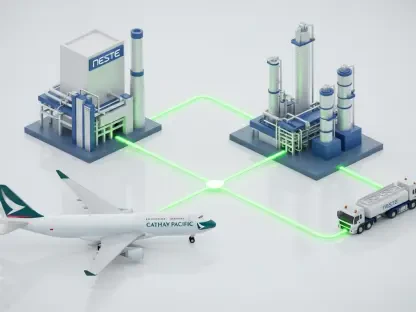The groundbreaking endeavor by Swiss start-up Sun-Ways aims to transform Switzerland’s existing railway infrastructure into renewable energy powerhouses. This ambitious project, recently green-lit by the Federal Office of Transport (FOT), involves the installation of removable solar panels on selected railway tracks. Launching with a three-year pilot phase in canton Neuchâtel, the project promises to make a significant dent in Switzerland’s renewable energy goals.
Project Kick-off and Technological Innovation
Approval and Initial Phase
Sun-Ways has secured approval from Swiss authorities to pilot their innovative solar technology on an active railway track in western Switzerland. Scheduled to begin in Spring 2025, the pilot phase will feature 48 solar panels installed over a 100-meter length of track. This initial phase, with an estimated cost of CHF585,000 ($681,000), will serve as a critical testing ground for the feasibility and impact of integrating solar panels into the railway system.
These specially designed panels will be mounted on railway sleepers, strategically positioned between the tracks, and will feed electricity directly into the local power grid. The initiative aims to explore the potential of leveraging existing railway infrastructure to boost renewable energy output without the need for additional land. By using the existing rail network, Sun-Ways hopes to circumvent some of the challenges often associated with large-scale solar projects, such as land acquisition and habitat disruption.
Unique Removable Panels
One of the standout features of Sun-Ways’ system is its removability. Unlike similar projects by Italy’s Greenrail and England’s Bankset Energy, Sun-Ways has developed a patented method for easy removal and reinstallation of solar panels using specialized railway machinery from Scheuchzer SA. This removability ensures that routine maintenance and repairs of the railway tracks can be conducted without unnecessary delays or complications.
This technological innovation is a significant step forward, offering more flexibility and efficiency in incorporating renewable energy solutions into established infrastructures. The ability to remove panels efficiently for any necessary track work underscores the project’s practicality and potential for scalability. Moreover, the removable feature enhances the longevity and safety of both the tracks and the panels, making it easier to address any emerging issues without disrupting either the rail or energy supply systems.
International Interest and Expansion Prospects
Global Appeal
Sun-Ways’ groundbreaking initiative has caught the attention of international entities, sparking discussions and pilot projects in countries such as France, South Korea, Spain, Romania, China, Thailand, Australia, and the United States. This global interest highlights the widespread recognition of the project’s innovative approach and its potential to be adapted to diverse geographical and infrastructural contexts. The wide range of climates and rail conditions in these regions makes them ideal testing grounds for the technology’s versatility.
The project’s patent-pending removable technology sets it apart, positioning Sun-Ways as a leader in pioneering sustainable energy solutions that maximize existing infrastructure. As discussions progress, the potential for international collaborations increases, setting the stage for broader implementation of this technology. Collaborations could bring not just technological advancements but also significant economic benefits, paving the way for a new global standard in utilizing railways for solar energy generation.
Expansion in Switzerland
Within Switzerland, there are plans to extend similar solar systems to private railroads, especially those serving industrial zones. This planned expansion demonstrates the versatile applications of Sun-Ways’ technology, addressing the energy needs of various sectors. As the pilot project progresses, it will provide valuable insights and data that could inform these broader applications and drive further renewable energy advancements domestically.
This willingness to adapt and expand within Switzerland showcases the national commitment to sustainable energy solutions. By tapping into private rail networks, Switzerland can create a more decentralized energy generation model, reducing the strain on the main grid and providing localized sources of renewable energy. Such an approach could also enhance energy security by diversifying the sources and locations of solar power production.
Environmental Impact and Challenges
Energy Production Potential
Sun-Ways estimates that complete implementation of their solar panel technology across Switzerland’s 5,317-kilometer rail network could produce up to 1 Terawatt-hour (TWh) of solar energy annually. This output represents about 2% of the country’s total electricity consumption, reflecting a substantial contribution to Switzerland’s renewable energy targets. Given Switzerland’s ambitious goal to achieve net-zero emissions by 2050, such an increase in renewable energy output would be a valuable asset in the national energy portfolio.
The Federal Office of Transport acknowledges the technology’s potential but insists on thorough evaluation during the pilot phase. Key factors under scrutiny include the long-term behavior of the tracks, maintenance requirements, wear and tear, and other operational aspects. The three-year pilot phase is anticipated to yield critical data, guiding future decisions and optimizations for widespread deployment.
Addressing Potential Issues
While the technology holds great promise, it is not without challenges. Concerns include the formation of micro-cracks on the panels, the risk of increased fire hazards, and the addition of noise from reflective panels. The International Union of Railways has highlighted these potential issues, emphasizing the importance of addressing them to ensure the project’s feasibility and safety. Testing during the pilot phase aims to mitigate these risks, and obtaining empirical evidence will be vital for assessing and addressing these concerns.
Sun-Ways plans to use the pilot phase to rigorously test and refine their technology, aiming to mitigate these risks. Continuous feedback and improvements based on real-world data will be critical to overcoming these challenges and enhancing the reliability and effectiveness of the system. Furthermore, collaborative efforts with safety and engineering experts will be essential to develop effective solutions and ensure the technology can be safely and widely adopted.
Context of Solar Energy Development in Switzerland
National Energy Goals
The Swiss government’s commitment to boosting solar power is central to its 2050 net-zero strategy. The country aims to generate 45 terawatt-hours of solar and wind electricity annually by 2050. Despite a growth rate of over 40% annually in the solar market since 2020, Switzerland still lags behind other European nations in per capita solar and wind energy production. This discrepancy underscores the need for innovative approaches, such as the Sun-Ways project, to accelerate renewable energy adoption.
Strategic initiatives like the Sun-Ways project are crucial for closing this gap and accelerating progress toward these energy goals. By integrating innovative technologies into everyday infrastructure, Switzerland can make significant strides in increasing its renewable energy output. The adaptation of railway infrastructure for solar energy production serves as a model of efficiently utilizing existing resources to meet new energy demands.
Legislative Support
Supportive legislative measures, such as the Electricity Law coming into effect in June 2024, are designed to create a more favorable environment for renewable energy investments. These changes aim to streamline the process for renewable energy projects, removing bureaucratic hurdles and providing incentives for investment. As regulatory frameworks become more accommodating, projects like Sun-Ways’ solar railway initiative can gain the momentum needed for large-scale deployment.
The legislative landscape is evolving to support renewable energy projects, ensuring that technological advancements can be translated into practical applications without undue delay. Coupled with financial incentives, these legislative measures are expected to foster a thriving renewable energy sector in Switzerland. By making the legal and economic conditions favorable, Switzerland aims to lead by example in the global transition to sustainable energy sources.
Conclusion
Swiss start-up Sun-Ways is set to revolutionize Switzerland’s railway system by integrating renewable energy sources. This innovative project, approved by the Federal Office of Transport (FOT), involves placing removable solar panels on select railway tracks. The initiative kicks off with a three-year pilot phase in the Neuchâtel canton and aims to transform the country’s extensive train network into a significant producer of renewable energy. The pilot phase will serve as a proof of concept, demonstrating the feasibility and effectiveness of using railway tracks to generate solar power.
By converting inactive track space into solar farms, Sun-Ways intends to make notable contributions to Switzerland’s renewable energy targets. This project not only maximizes the use of existing infrastructure but also reduces the environmental impact of energy production. If successful, this approach could be expanded nationwide and potentially even globally. The pilot phase will gather essential data and insights, laying the groundwork for a large-scale rollout that could significantly boost Switzerland’s renewable energy output and sustainability goals.









